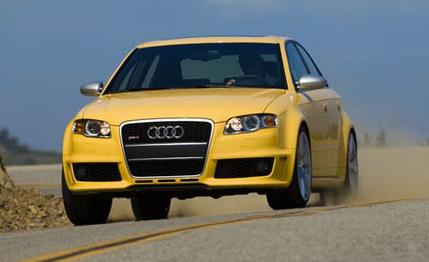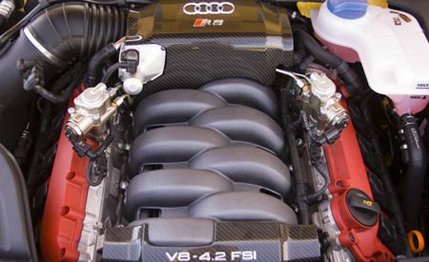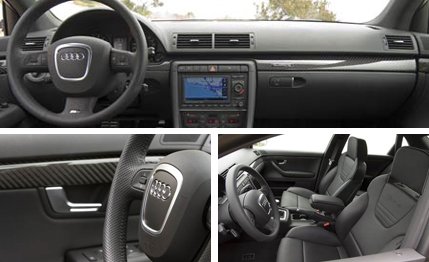
 Road Test
TESTED
Road Test
TESTED
At 150 mph down the long straight at our high-desert testing ground, the '07 Audi RS 4 performs the same gentle rear-end boogie I remember from an autobahn experience with it in Germany. That particular dance partner was a German model we were testing alongside a BMW and Mercedes-Benz, and all three drivers that day remarked on the peculiar rear-end gyration.
For a car designed and developed within a stone's throw of the world's fastest public roads, it's a strange inconsistency. At the big track at Willow Springs International Motorsports Park in Southern California where Audi staged its stateside introduction, the RS 4 would reach maybe 130 mph down the pit straight. At that speed there was no sign of any tail wiggle. But when you got on the brakes hard for Turn Two, there it was again, the slo-mo shimmy.
These mild oscillations never get troublesome, but we're curious about their origin. Perhaps it has something to do with the Quattro all-wheel drive, or the car's 58.3/41.7-percent front-to-rear weight distribution. We can't be certain. But here's something we are sure about. Not many owners will ever see speeds that high. Heaven knows, it's hard enough for us to find appropriate test venues. Most racetracks don't have straights long enough to allow this kind of speed.


Still, you don't need huge top speed to enjoy the RS 4's 420-hp direct-injection V-8. Just about anywhere will do. The engine pulls smoothly from idle, with abundant thrust available from 2300 rpm. In fact, 90 percent of the car's peak torque is available between 2250 and 7600 rpm.
With its 420-hp peak in full bloom at 7800 rpm, the RS 4 is blessed with an engine that is flexible and rev happy. That's what makes a 4.6-second 0-to-60 time possible — despite the problems encountered getting a good launch with all-wheel drive in 97-degree heat and an altitude of 2000 feet. Sure, we correct for weather, but breaking traction in these conditions to keep the revs up is virtually impossible. The RS 4 runs the quarter in 13.2 seconds at 109 mph, and that's a real measure of its potential.
Another sign of how serious Audi is about its high-performance credentials can be seen in the fact that it now fields two go-faster models based on its mid-size A4 sedan: the continuing $47,120 340-hp S4 and this new RS 4. That the RS 4 is being priced at $68,820 for the U.S. market is surprisingly good news. It's a lot, but it's almost the same number of euros required for the RS 4 in Europe, which at the current exchange would cost an American $83,857. Of course, some changes have been made to the car coming to our shores. For one, the flat-bottom steering wheel fitted to Euro cars has been replaced with the wheel you see in these photographs.


Clad in perforated leather and equipped with radio control switches, our wheel is perfectly pleasant in use, but its implementation has moved the car's sport button — it steps up throttle response and opens an exhaust valve for a sportier sound — to the dashboard. Another big change is the use of conventional ignition-key starting. The European model has a start button on the console. No big deal. We complained about it in our earlier examination ["Rocket Sedans," C/D, September 2005], wondering why you'd want to duplicate functions when there was a conventional ignition key anyway. This way, starting is a one-step process. We prefer that.
Another big difference between cars on the two continents is the replacement of the lightweight European race-type seats with 10-way power-adjustable Recaros. These do not afford quite the support we were looking for on the track, but they worked great everywhere else, even during high-speed work in the mountains. They are a lot easier to get into and out of, too; the Euro chairs have pronounced hip bolsters that will give you a wedgie you'll remember for a long time if you sit in the wrong spot.
With all that leather and carbon-fiber trim, the Audi RS 4 looks decidedly sporty inside. But despite the overtly athletic nature of the car — and the many strategies to reduce its weight — the interior is replete with modern gadgets. Standard equipment includes a sunroof, a lap timer, rear Parktronic, and heated front seats. Our car had the optional Premium package that adds a navigation system, a 10-speaker Bose/Audi Symphony stereo system with a CD changer in the glove box, and heated rear seats.